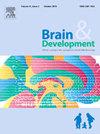低髓鞘性脑白质营养不良的磁共振成像与光谱分析
IF 1.4
4区 医学
Q4 CLINICAL NEUROLOGY
引用次数: 0
摘要
分子生物学和放射学的最新进展导致了几种新的白质营养不良的鉴定。脑白质营养不良的一个关键诊断特征是在t2加权磁共振(MR)图像上观察到白质信号强度增加。脑白质营养不良通常分为两大类:低髓鞘性脑白质营养不良(HLD)和其他形式,包括脱髓鞘性脑白质营养不良。HLD的特点是髓磷脂的原发性缺陷,这是由于影响髓磷脂结构蛋白、少突胶质细胞转录因子、RNA翻译和溶酶体蛋白的遗传变异。放射学上,与脱髓鞘性脑白质营养不良相比,HLD在t2加权图像上往往表现出不那么明显的白质高信号。明确的诊断通常可以通过确定白质以外区域的异常,如基底神经节或小脑,或通过出现特征性临床症状。n -乙酰天冬氨酸是一种神经轴突标记物,在许多神经系统疾病中通常会减少,但在HLD中n -乙酰天冬氨酸水平通常保持正常,这被认为是这种疾病的一个显著特征。本文概述了与HLD相关的最新影像学表现和临床特征。本文章由计算机程序翻译,如有差异,请以英文原文为准。
Magnetic resonance imaging and spectroscopy in hypomyelinating leukodystrophy
Recent advancements in molecular biology and radiology have led to the identification of several new leukodystrophies. A key diagnostic feature of leukodystrophies is the increased white matter signal intensity observed on T2-weighted magnetic resonance (MR) images. Leukodystrophies are typically classified into two main categories: hypomyelinating leukodystrophies (HLD) and other forms, including demyelinating leukodystrophies. HLD is characterized by a primary defect in myelin due to genetic variants that affect structural myelin proteins, oligodendrocyte transcription factors, RNA translation, and lysosomal proteins. Radiologically, HLD tends to show less pronounced white matter hyperintensity on T2-weighted images than demyelinating leukodystrophies. A definitive diagnosis can often be made by identifying abnormalities in regions beyond the white matter, such as the basal ganglia or cerebellum, or through the presence of characteristic clinical symptoms. N-acetylaspartate, a neuroaxonal marker observed on MR spectroscopy, is typically reduced in many neurological conditions, but N-acetylaspartate levels often remain normal in HLD, which is considered a distinctive feature of this disorder. This article provides an overview of the latest imaging findings and clinical features associated with HLD.
求助全文
通过发布文献求助,成功后即可免费获取论文全文。
去求助
来源期刊

Brain & Development
医学-临床神经学
CiteScore
3.60
自引率
0.00%
发文量
153
审稿时长
50 days
期刊介绍:
Brain and Development (ISSN 0387-7604) is the Official Journal of the Japanese Society of Child Neurology, and is aimed to promote clinical child neurology and developmental neuroscience.
The journal is devoted to publishing Review Articles, Full Length Original Papers, Case Reports and Letters to the Editor in the field of Child Neurology and related sciences. Proceedings of meetings, and professional announcements will be published at the Editor''s discretion. Letters concerning articles published in Brain and Development and other relevant issues are also welcome.
 求助内容:
求助内容: 应助结果提醒方式:
应助结果提醒方式:


